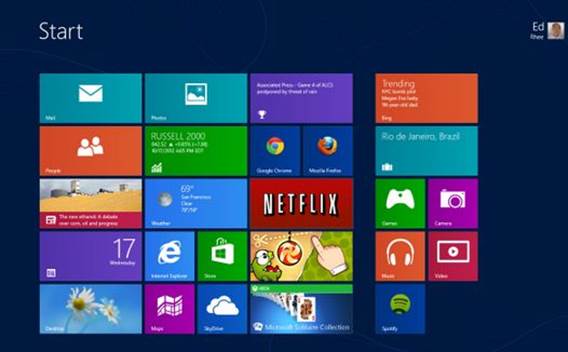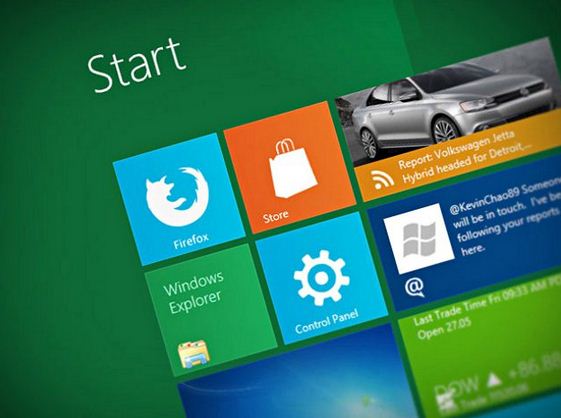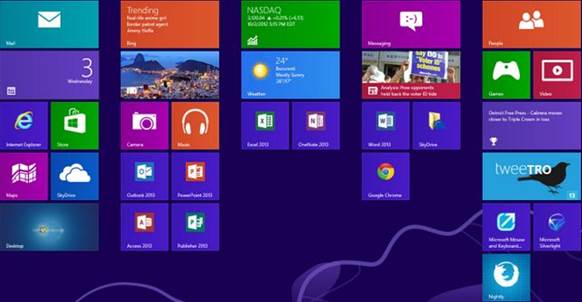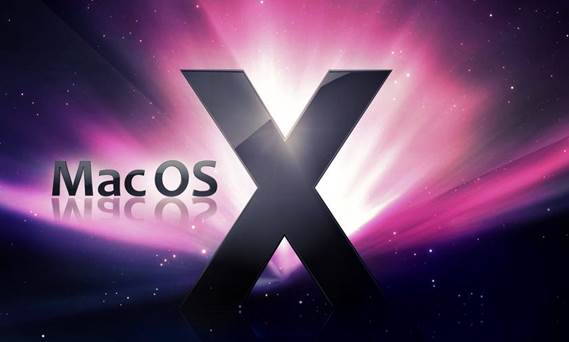Interface Design
Appearance
Windows8
Let's start with the new Modern UI. There's
no doubt that this represents one of the boldest moves made by Microsoft in
Windows' history, and each new Windows device proudly displays the colorful and
dynamic design.
The Start screen, which replaces the old
Start Menu, is an interesting environment. Large boxes form a multicolored grid
that sits on top of a customizable background. Several tiles are live,
frequently updating themselves to reveal the latest sports news, search trends
on Bing, weather in your location, or news headlines. The desktop app tile
displays the wallpaper in use on the traditional Windows desktop.

The
Start screen, which replaces the old Start Menu, is an interesting environment.
The use of images to accompany the
constantly changing news makes the Start screen experience seem alive and
interesting, almost to the point of distraction. Leaving open this Start screen
while perusing a document on a second screen can be a hazardous affair: your
eye will invariably be drawn to the flashing and flickering of transfer rumors,
or the startling news that dolphins are one of the most searched-for terms on
the internet today.
For the more organized user, there's the
option to group the icons in columns. This is achieved by dragging them into a
new grid, then using the pinch gesture (or mouse's scroll-wheel) to zoom out,
clicking on the column and then naming it.
Selecting any one of these icons causes it
to expand, flip over, and launch the app. This introduces another significant
change to the Windows experience: the full¬ screen app. When using the
traditional desktop you can resize individual panes to suit your preference and
available screen space. But in the Modern UI, full-screen apps are the order of
the day.
The one concession is a 'snapping' feature
that allows you to stretch an app over three quarters of the screen, with
another app squeezed into the remaining quarter. For Twitter feeds and other
list- based apps this can work well, but if you want to run anything more
complicated then you'll need to invest in a second monitor or develop a deep
kinship with the Windows, Tab shortcut.

But
in the Modern UI, full-screen apps are the order of the day.
This is where the tablet-like nature of the
new design begins to rear its head, and may cause those who have grown up using
Windows some confusion. Many of the Modern UI apps also have simplified layouts
and functionalities (we'll cover this in more depth later). Even the symbols
for loading or processing have been tweaked, with users now watching five
little balls orbit around an invisible sun, or a colored line advancing across
the top of the screen until the job has been completed.
Windows 8 looks like a modern OS. When you
consider its clean lines and the expanses of empty white space of ten found
onscreen, it seems oddly similar to Google's most recent version of Android,
mixed with a dash of Apple's traditional minimalism.
The Modern Ul is a stark departure from the
traditional desktop, which you'll still use to run legacy applications such as
Microsoft Office, Photoshop and your web browser — for the time being, in any
case.
On the desktop you can run programs written
for Windows 7, Vista or XP, and navigation is largely the same as in previous
versions. However, you might want to change several default application
settings to prevent situations where you click on, say, an image file on the
desktop, and are transported to the Modern UI's Photos app to view and/or edit
it. Some people might not mind this switching about, while others will find it
grating. We'll explain all later in this feature.
These are all set-and-forget fixes, but
during your first few hours in the new environment you may well feel a bit lost
- especially if you're not confident when it comes to altering Windows'
settings.

On
the desktop you can run programs written for Windows 7, Vista or XP, and
navigation is largely the same as in previous versions.
Arguably the most frustrating element is
that Modern UI apps don't have buttons that allow you to hide or close the
window; instead, you drag your finger (or mouse cursor) down from the top of
the screen to exit the app, or swipe in from the left side to switch between
apps.
If you don't have a touchscreen then
pressing Windows, Tab lets you navigate between open Modern UI apps, and Alt, Tab
will cycle through everything. Those who prefer to use their mouse for
everything will quickly discover the screen's new 'hot' corners: put the cursor
in either left corner to display a list of running apps, or the right corners
to bring up the Charms bar.
OS X
OS X 10.8 is a windowing OS and much more
like Windows 7 than Windows 8, so it's not as difficult as you might expect to
switch from XP, Vista or Windows 7.
The latest version is called Mountain Lion,
with previous iterations also named after big cats. Instead of fancy new graphics
or unified layouts, Mountain Lion instead gets a carefully administered sheen
of polish, with some useful features that make your life that bit easier.

By
default the OS X desktop is empty, with a dock at the bottom of the screen
providing shortcuts to the various programs you can launch.
By default the OS X desktop is empty, with
a dock at the bottom of the screen providing shortcuts to the various programs
you can launch. You can achieve a similar look in either Windows 7 or 8 by
pinning shortcuts to the taskbar.
Icons are magnified as you move the mouse
cursor over the dock, which you'll either find helpful or annoying. This action
is disabled by default. The dock can also hide itself away when not in use.

Since
the release of OS X Lion, Apple has also included in many of its apps a
full-screen button.
Apple's approach to minimizing and
maximizing Windows has always been a tad confusing. Clicking the green + button
(zoom) can sometimes mean the window increases to fill the screen (while
retaining the menu bars at the top); on other occasions it fills only the
height of the screen.
Since the release of OS X Lion, Apple has
also included in many of its apps a full-screen button. This not only expands
the window in question, but removes the top menu to utilize the entire screen.
So, while Apple was first to approach the concept of full-screen apps, Windows
was first to make them mandatory.